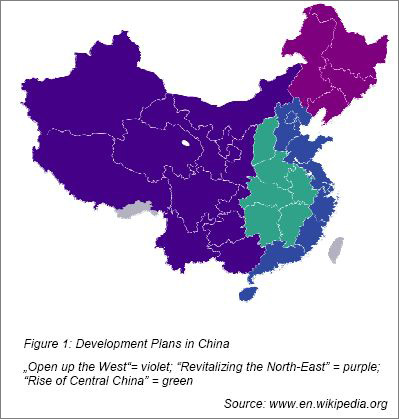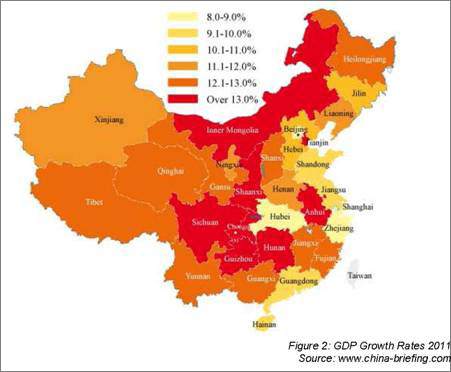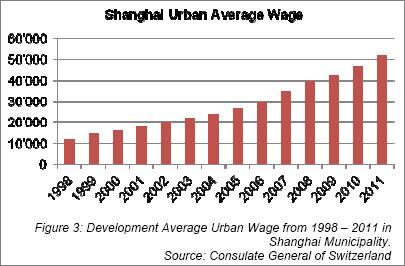
| Issue N° 4 - October 2012 |
|
The “Rise of Central China" Plan:
Download Shanghai Flash N° 4/2012 pdf-version Accelerating the development of Central China is an important aspect of our endeavors to ensure well-balanced development of regional economies” (Premier Wen Jiabao 10th Session of the National People's Congress 2004) “The central region should become China's major grain production base, production base of raw materials and energy sources, new and high-tech industrial base, manufacturing base of modern equipment and comprehensive transportation hubs.“ (Xinhua News Agency 15.02.2006) 1. Introduction “It is OK for some people to get rich first” It is with these words that the father of China's Reform-and Opening Policy Deng Xiaoping laid the basis for the rapid and fruitful development of China's Eastern coastal provinces, namely the coastal cities and Special Economic Development Zones SEDZ, which benefited to an enormous extent from his Reform-and Opening Policy, much more than the rest of China. In 1999 the central government announced the “Open Up the West”(西部大开发 ) plan, for the development of China's least developed regions in the west: the provinces Gansu, Guizhou, Qinghai, Shaanxi, Sichuan, Yunnan as well as the Autonomous Regions of Guangxi, Inner Mongolia, Ningxia, Tibet and Xinjiang.
In March 2004, Premier Wen Jiabao announced the “Rise of Central China” Plan (中部崛起计划 ), focusing on Anhui, Shanxi, Henan, Hubei, Hunan, and Jiangxi. The central region was characterized by its economic focus on agriculture (which is why Central China is also known as “China's breadbasket”), its relatively big population (28% of Mainland China), and an origin of migrant considerably slower compared to the coastal provinces, and the region's GDP did not grow at the rate as the of the gross national average – in 2003, it had shrunken to only 75% of the average national GDP.1 The “Rise of Central China” Plan (RCCP) focuses on enhancing the assets the Central Region already possesses: its agricultural production should become more scientific as well as more efficient and high-yielding, Central China should be further upgraded to a transportation hub connecting North and South as well as East and West through several high-speed railway networks, its abundant energyand raw material resources, such as coal, should be exploited more effectively and the extracting industry should be modernized to be more efficient and eco-friendly, and urbanization should be fostered.2 The effects of the “Rise of Central China” Plan are clearly visible – the GDP in all six provinces has been rising considerably since the implementation in 2004, and continues to do so: The GDP of Anhui province for example was around 481 billion RMB in 2004, in 2011 it reached 1.5 trillion RMB3, and for 2012 a further increase of roughly 12% is projected4, with the other five provinces making up “Central China” enjoying similar outlooks.
2. Anhui's Objectives in the “Rise of Central China” Plan At the time of the introduction of the “Rise of Central China” plan, Anhui was the least economically developed province in Central China: its GDP (total and per capita) was the lowest in Central China, the revenue of the Anhui government in 2004 was at 7 billion RMB while the local government in Henan had 43 billion RMB at its disposal. 16% of Anhui's population had left the province in order to find work in cities like Shanghai or Beijing.5 Under the RCCP, Anhui was taking different steps to address its structural deficits in order to gain competitive edge, some of which are listed below:
3. Development and Prospects for Anhui Province
Anhui is benefiting considerably from from its prime location neighboring Jiangsu province, Zhejiang province and Shanghai municipality. Its FDI reached 6.6 billion $ in 2011 while the number was only 0.69 billion $ in 2005. The retail sales of consumer goods grew 18.8 % in July year-on-year to 20.23 billion RMB, foreign trade value from January-July 2012 stood at 432 billion $, a 50.5% increase compared to the same period in 2011.9 Consumer goods giant Unilever has moved its production base from shanghai to Heifei in 2005 and has started an expansion project in 2011, which will become its biggest comprehensive production base for daily-use chemicals and foodstuffs around the world. Continental, one of the world's leading automotive suppliers and tire producers, expands its production plant in Hefei in March 2012. With €134 million investment, the production capacity will be increased from 4 million to 8 million passenger car tires annually. Samsung has now established a presence in Anhui, UPS invested 100 million RMB in 2011 into a business park in Hefei and JA Solar started to set up the world's largest integrated solar energy production center in Hefei.10 Swiss presence in Anhui is not as intensive as in the neighboring provinces. ABB Group set up an ABB Transformer plant in 1992. At present, ABB Hefei has become a sizeable company which hired more than 800 employees with comprehensive range of transformer products. Adequate means of transportation seems to be the crucial point for Anhui's development. With the new High-Speed Train Network in place, travel time from Hefei to Shanghai has been reduced from over 6 hours to 2.5 hours. Consequently, Hefei with its relatively cheaper prices for land and labor will be an increasingly attractive destination for investment, especially by companies whose operations are land- and labor intensive and for whom the sky rocketing prices in the coastal areas are becoming problematic. Like this, they can avoid having to move their operation out of the country altogether, but are able to further benefit from their China-knowledge that they acquired over the years.12 Anhui not only benefits from investment-flows from the Yangtze-Delta-Region: Air China has increased the number of flights to and from Hefei by 60% in March 2012, with now four daily flights to and from Beijing, three between Hefei and Shanghai, two between Kunming, Guangzhou, Chengdu and Hefei, three direct flights per week between Hefei and Hong Kong, as well as two weekly flights between Taipei and Hefei. This sharp increase in flights is a manifestation of the increasing importance of Hefei as a cluster-city, and Anhui as a province on the rise.13 4. Conclusion After the implementation of Deng Xiaoping's Reform and Opening Policy, the eastern and coastal provinces began to thrive with economic development, while the rest of China fell behind. Inequality was increasing sharply, and state owned enterprises were forced to shut down leading to mass layoffs which in turn triggered social unrests. The first region to benefit from a tailor-made development program was the western region, as the economic and social situation (ethnic unrests were on the rise) was most dire. The Central region of which Anhui is part was the last region to be included in a regional development program – because the central region was able to profit more from the eastern economic miracle due to geographic proximity, because their infrastructure had been better than the one of western China to begin with, and simply put because it had been relatively peaceful. The measures that have been taken to strengthen Central China were not as extensive as for example the investment program for China's West, it was much more selective, yet just as successful if not more: While the economic growth in the traditional economic hubs seems to slow down, Central China is thriving, especially Anhui province with the latest GDP growth rate of 13.5%. Business analysts such as KPMG14 are expecting Central China to be the driving force behind China's further economic growth – it offers excellent geographical location, relatively cheap land and labor, unsaturated domestic markets, increasingly high skilled labor force – all the advantages the coastal provinces offered in the 1980s. Bearing the coastal province's story of success in mind, it does not seem over the top to expect great things from Central China in the years to come. Report by Anna Marti 1 http://www.china.org.cn/english/2005/Apr/127545.htm [accessed 15.08.2012, 14.55] 2. See Wen, Ruchun (2010): The Study of the Economic Development Strategy of Central China, in: Proceedings of 2010 International Conference on Regional Management Science and Engineering pp 322 ff. 3 http://www.china.org.cn/top10/2012-03/22/content_24940825_3.htm [accessed 26.08.2012 15:20] 4 http://english.anhuinews.com/system/2012/07/10/005072443.shtml [accessed 26.08.2012 15:20] 5 Jin Zhaofeng; Zhu Weisheng (2005): China Statistical Abstract 2005, China Statistics Press, Beijing pp. 25 ff, 42, 55, 72, 108, 113, 163 ff. 6 http://www.english.ah.gov.cn/ahrise/mainmenu.asp?newsid=89&kind=hasmenu&name=DT&title= Retrospection of the 2000-2005 Social & Economic Development in Anhui 7 For further Information see http://www.isn.ethz.ch/isn/Digital-Library/ISNInsights/ Detail?lng=en&id=128073&tabid=1450691584&contextid734=128073&contextid735=127105 [accessed 28.08.2012 16:55] 8 http://english.ah.gov.cn/ahrise/mainmenu.asp?newsid=89&kind=hasmenu&name=DT&title= Retrospection of the 2000-2005 Social & Economic Development in Anhui 9 http://english.anhuinews.com/system/2012/08/20/005156523.shtml [accessed 30.08.2012 16:32] 10 http://chinaenergysector.com/2011/04/18/anhui-province-good-solar-power-prospects/ 12 Yang, Guanghua; Li, Xiamiao (2010): “On the Effects of Modern Logistics to Prosperous Central China” p. 1341 ff. 13 http://english.anhuinews.com/system/2012/03/26/004862644.shtml [accessed 30.08.2012 16:32] 14 http://www.kpmg.de/Themen/8717.htm 19.12.2013 Consulate
General of Switzerland |
Back to the top of the page
Page created and hosted by SinOptic
 Encouraged by the apparent success of the Western Strategy, the “Revitalize The Old Northeast Industrial Bases”(振兴东北老工业基地 ) focusing on the provinces Liaoning, Jilin, Heilongjiang and five eastern prefectures of the Autonomous Region Inner Mongolia was introduced in 2003 by Premier Minister Wen Jiabao.
Encouraged by the apparent success of the Western Strategy, the “Revitalize The Old Northeast Industrial Bases”(振兴东北老工业基地 ) focusing on the provinces Liaoning, Jilin, Heilongjiang and five eastern prefectures of the Autonomous Region Inner Mongolia was introduced in 2003 by Premier Minister Wen Jiabao.
 Central China will benefit from shifting comparative advantages – land and labor costs are substantially cheaper than in welldeveloped areas, such as the Yangtze-Delta-Region, which are under market pressure to shift away from land- and labor intensive manufacturing to more capital- and knowledge-intensive operations.
Central China will benefit from shifting comparative advantages – land and labor costs are substantially cheaper than in welldeveloped areas, such as the Yangtze-Delta-Region, which are under market pressure to shift away from land- and labor intensive manufacturing to more capital- and knowledge-intensive operations.